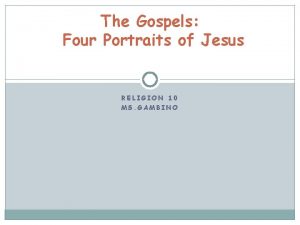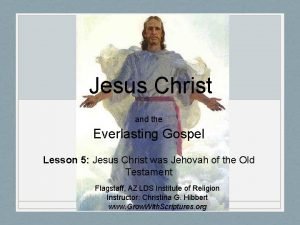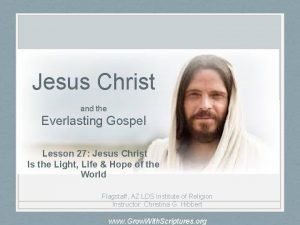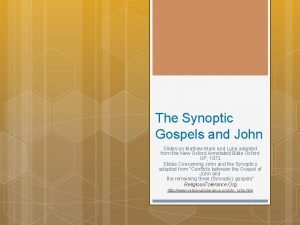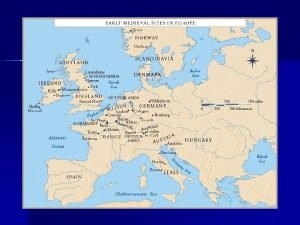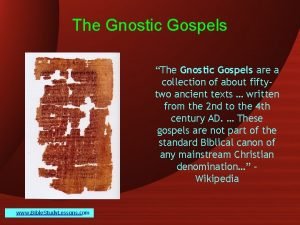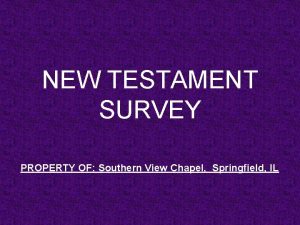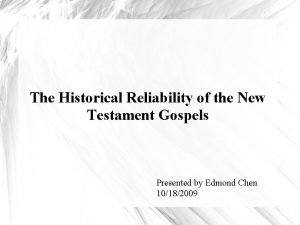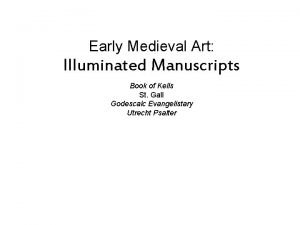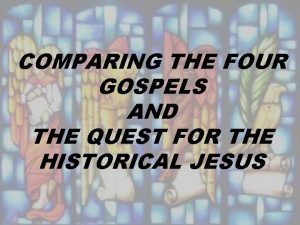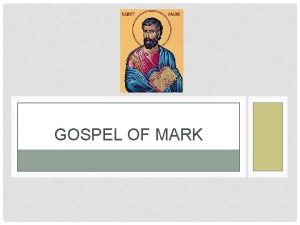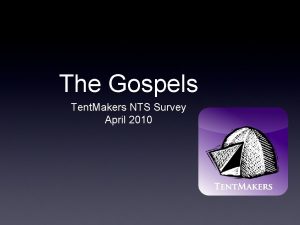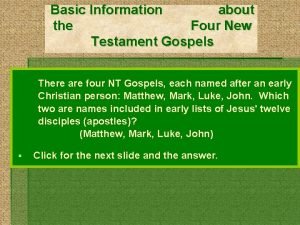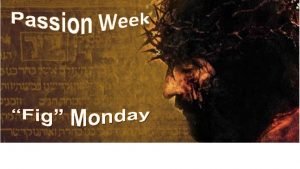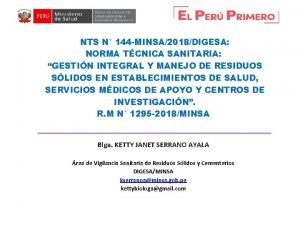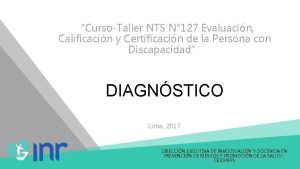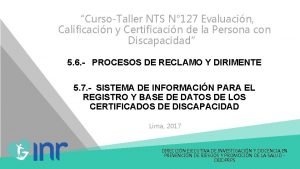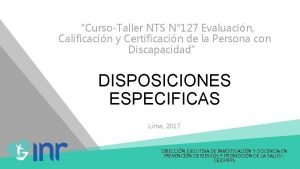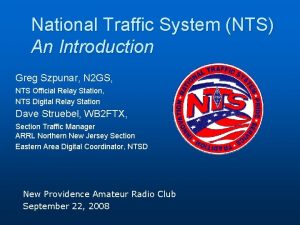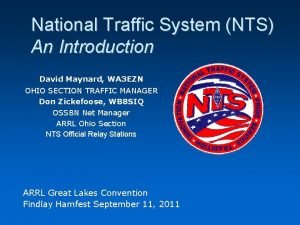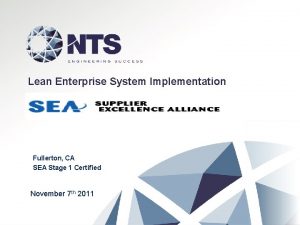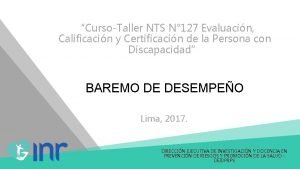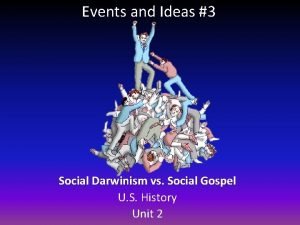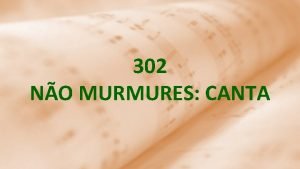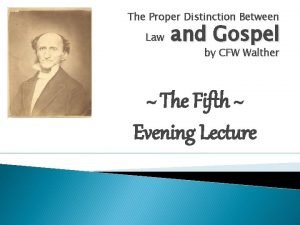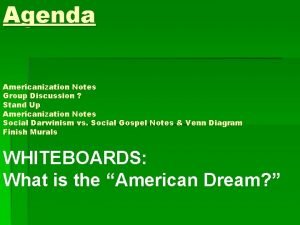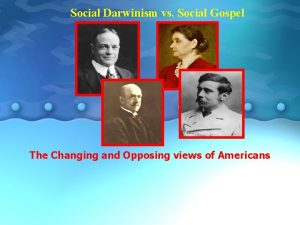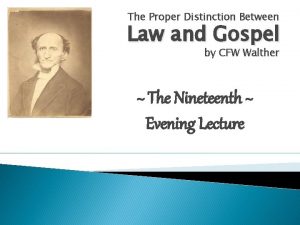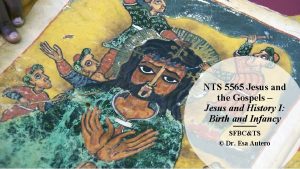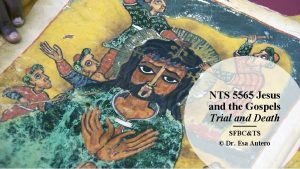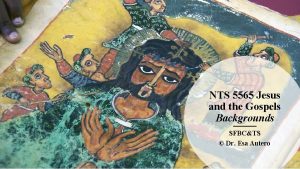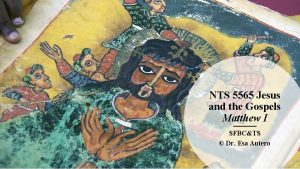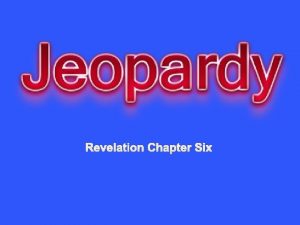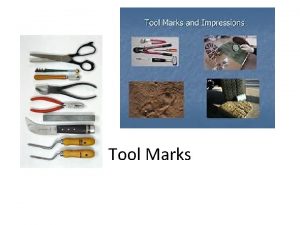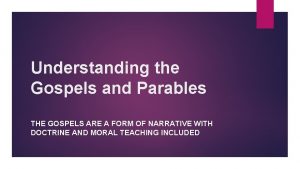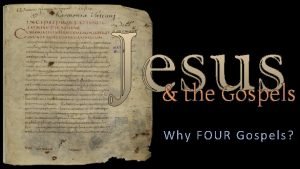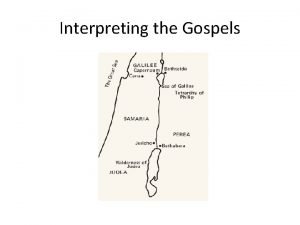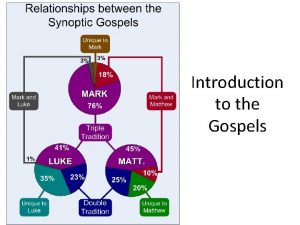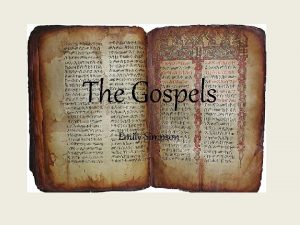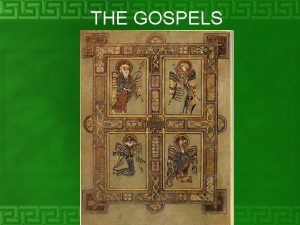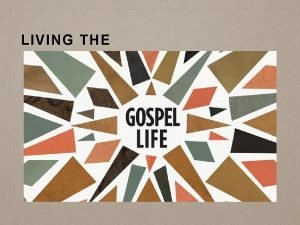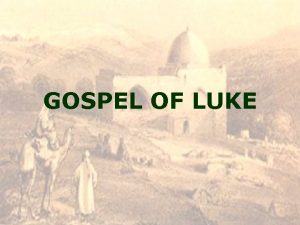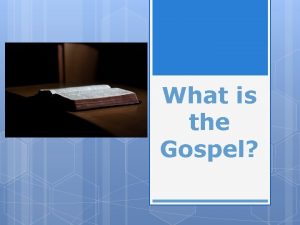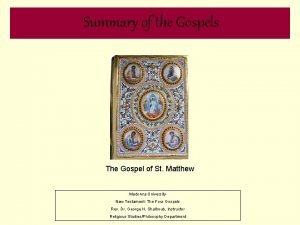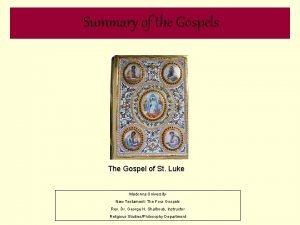NTS 5565 Jesus and the Gospels Marks Gospel


















































- Slides: 50

NTS 5565 Jesus and the Gospels Mark’s Gospel II SFBC&TS © Dr. Esa Autero

Jesus and the Gospels • Brief explanatory notes on the Gospel of Mark* (8: 22 -16: 8) • Physical and spiritual sight (8: 22 -9: 1) • Blind Man in Bethsaida healed (8: 22 -26) • Disciples spiritually deaf and blind (8: 17 -21) – blind man healed • Dramatization of disciples’ two-stage spiritual healing • Connection to 7: 31 -37 via Isa 35: 5 -6, “touch, ” “removal”**, spittle • From blindness to severe nearsightedness to full clarity • Peter’s declaration of Jesus as Messiah (8: 27 -30) • Disciples’ nearsightedness exemplified by Peter’s declaration and subsequent misunderstanding of its significance • “Messiah must suffer” x 3 (8: 31 -38; 9: 30 -32; 10: 32 -34) + misunderstanding and clarification by Jesus

Jesus and the Gospels • Misunderstanding the Messiah (8: 31 -10: 45) framed by healings of the blind men (8: 22 -26; 10: 46 -52) 1) Blind man’s eyes opened in two-stage healing (8: 22 -26) 2) Peter’s confession “Messiah” “Messiah must suffer” “Peter rebukes Jesus” “Get behind me Satan” (8: 33) “carry cross” (8: 34) 3) “The So. M is betrayed” (9: 30) “who’s greatest? ” (9: 33) “first must Inclusio be last…like a child” (9: 35 -37) (framing) 4) “So. M handed over” (10: 32 -34) “sit at your right hand? ” (35 -40) “So. M came to give life as ransom” (10: 45) 5) Healing of blind Bartimeus (10: 46 -52) – “faith…followed him…”

Jesus and the Gospels • Only God (1: 11) and demons so far know Jesus’ true identity (1: 24, 34; 3: 12; 5: 7); and reader (1: 1) – Peter’s understanding still very limited • Peter’s idea of Messiah closer to popular understanding – it’s partially correct but needs further insight • Jesus foretells His death (8: 31 -9: 1) • Idea of suffering Messiah foreign to Judaism – hence the difficulty • Contradiction in Peter’s mind: God is Messiah – Messiah will suffer • Peter under sway of Satan unknowingly b/c of spiritual blindness • 8: 31 -10: 52 focuses on Messiah’s and disciples’ suffering • Cost of discipleship closely tied to suffering of Jesus • “take up cross” – image of horror & violent death by Romans Get ready for trouble – a lot of trouble, not for thrones & glory!

Jesus and the Gospels • “deny self” “follow me” – walking behind Jesus forsaking all and ending up executed on the cross just as Jesus did • Loosing life for the sake of Christ and the gospel • “being ashamed…” “Son of Man ashamed” glory of Father and angels (Dan 7: 13 -14) – reference to 2 nd coming and vindication • “Some standing…until Kingdom comes in power” --- ? ? ? • Difficult to see as a reference to 2 nd coming of Jesus • Otherwise a flat contradiction/error – why included into the Gospels? * • Reference to transfiguration (cf. Matt 16: 28; Luke 9: 27) and as prefiguration of Jesus’ resurrection and ascension to heavenly throne This inaugurated Christ’s heavenly reign in power (1 Cor 15: 20 -28) Jesus’ contemporaries (friends and foes) would see Christ’s vindication and initiation of His heavenly reign which Transfiguration prefigured

Jesus and the Gospels • Jesus’ Transfiguration and dedscend from the mountain (9: 2 -29) • Transfiguration and Elijah (9: 2 -13) • Jesus’ direct teaching about His suffering (8: 31) – and now His glory • Jesus mentioned His glorious coming (8: 38 -39) – now a glimpse of it • “Six after…[after sayings]” (8: 38 -9: 1) – Luke “after about 8 days” (9: 28) • “ 6 days” allusion to Ex 24: 14 (Moses to Mt. to get revelation)? Disciples about to get a revelation that surpasses that of Moses • “Jesus dazzling appearance” – clothed w/ glory like God (Dan 7: 9)* Jesus is more than “Messiah”, clothed with divine glory • Moses and Elijah – representative of OT Law and prophets endorse Jesus --- allusion to Deut 18: 15 “listen to Him” in v. 7 • Elijah’s & Messiah’s role explained – disciples don’t get it (vv. 9 -13)** • Peter’s misunderstanding – confusion/awe (kingdom fully here? )

Jesus and the Gospels • God’s voice confirms Jesus as “Beloved Son” (cf. 1: 11) who has a status that is greater than all prior “sons of God” (angels, kings, prophets, messengers in OT) • “Cloud” = theophany (Ex 16: 10; 19: 9; 24: 15 -18; 34: 5; 40: 34 -38) • “Listen to Him” – obey, suffer, complete your mission • “tell no one until…” (v. 9) Jesus’ true identity understood only after death and suffering – and then followed by mission of disciples/church b/f final glorious return • Transfiguration – a foretaste of Christ’s glory and power Glory, power, healings – can only be understood in light of suffering Christ and His followers

Transfiguration – contrasted with “earthly realities” where lack of faith is a constant threat but Christ still powerful and • Boy with an evil Spirit (9: 14 -29) merciful healer • Lengthiest account on the story among synoptics Jesus and the Gospels • Argument – disciples unable to cast out a spirit from a boy • Failure immediately after “Mt. top experience” (cf. Ex 32) – scribes are like antagonistic Israelites during Moses’ time • Disciples fail in “faith” though see Christ’s glory – “How long? ” a message also to post-resurrection church? • Desperate situation of the boy – match with strong faith (that disciples lack). Struggle of faith that leads to healing “I believe, help my unbelief” shows power and compassion of Christ • “Boy was like dead” – “lifted to his feet” – foreshadowing of resurrection Disciples challenged to faith and prayer, continue “earthly mission”

Jesus and the Gospels • Jesus’ Death and Discipleship (9: 30 -50) • Jesus predicts His death 2 nd time (9: 30 -32) • So. M handed over to death – disciples don’t understand • New element: “handed over to human hands” (v. 31 “great suffering”) • “hand over” – term w/ double meaning: 1) Hand over w/ deceit (Judas, 14: 41 -42); 2) God “hands over” Jesus for suffering and redemption of humanity (Rom 8: 32; cf. 1: 24, 26, 28) Who “hands Jesus over”? Judas but as part of God’ sovereign plan Focus on • Who’s the Greatest? (9: 33 -37) Misunderstanding continues • Arguments among disciples – 9: 50 “be at peace with one another” discipleship and “getting along” • Ranks and hierarchy among disciples? Honor/shame culture and strict ranking per “spiritual worthiness” among Qumran and other groups

Jesus and the Gospels • Children not “cute” and “priority” or example of trust or humility (latter in 10: 13 -16) – loved by parents but like slaves to some extent in terms of obedience and subordinate status (cf. Gal 4: 1 -3) • “last” and “child” juxtaposed – reference to lowly status • “child” also a symbol for fellow believer (v. 42) – receiving a child, that is a fellow believer (“in my name” – because they belong to me) Even lowliest/most insignificant to be treated w/ great respect • Another exorcist (9: 38 -41) • “someone casting out demon in Jesus name” – related to previous story? • Someone outside of 12 disciples using “Jesus name” to do wonders Matt 7: 21 -23 • Charlatan (cf. Acts 19: 11 -20) OR genuine follower of Christ warns of false • Point? Whether someone outside 12 may be a genuine follower of Christprophets casting Benefit of doubt given to all unless there are reasons otherwise – also out demons “in my importance of hospitality added (v. 41) name”

Jesus and the Gospels • Temptations and stumbling (9: 42 -50) • Catch word connection “little ones” (v. 42) to “child” (v. 37) • “little ones” – Christ believer • Warning about “putting stumbling block” – causing severe sin as the consequence “millstone around neck and into sea” (v. 42) • Warning as a balance to “reward” for hospitality (v. 41) • Warning not to cause “others to fall” – “be alert yourself” (vv. 43 -48) • Hyberbole – cut/tear off hand, foot, eye – “better…enter life” (kingdom of God) maimed/partially intact than hell fully intact* Take every possible measure to cut off from temptations and enter life – kingdom worth any kind of sacrifice

( כי־מצא בה ערות דבר shameful, nakedness) Jesus and the Gospels [unseemly, indecend, unattractive] (Deut 24: 1) εὗρεν ἐν αὐτῇ ἄσχημον πρᾶγμα • “fire of hell” a catch word connection to “salted with fire” Not reference to eternal fire but “fire of testing” on earth • “Salt” reference to humility/dedication that comes through trials • Unrefined salt could loose saltiness (unlike refined)* • Maintaining this “salt” helps disciples to live peacefully together • Marriage, Children, and Possessions (10: 1 -31) – in discipleship • Section on discipleship w/ focus on earthly ties (family, money) • Marriage and divorce (10: 1 -12) – responsibility and place of strife** • In Judaism only men could divorce – Greco-Roman allowed women • Disputes over proper reason for divorce based on Deut 24: 1 -4 found some • Hillel – almost anything & Shammai – only sexual immorality indecency in he (Deut 24: 1)

Jesus and the Gospels • Mark reflects gentile setting – Matt 19: 1 -12 (5: 31 -32) Jewish setting • Implications drawn for gentile audience • Pharisees test Jesus – perhaps on account of Herod (6: 14 -29) to trap him into saying something to denounce him to Herod • John the Baptist’s criticism likely akin to “revolt” per Herod • Jesus lays aside Deut 24: 1 -4 – provisional statement on account of “hard hearts” (like Pharaoh) offensive as a sort of depreciation of the perfection and sanctity of Scripture • Law adapted to fallen human condition – original creation mandate supersedes Mosaic requirement • Gen 1: 27 – equal partnership of men and women emphasized • Gen 2: 24 – one flesh union w/ emphasis of man leaving parents for the sake of the wife (divorce often insurmountable burden for wife)

“The person who imagines being worthy of God’s favor and participation in the kingdom depends on social or religious rank will never enter the kingdom” (cf. 9: 33 -37) (Hurtado 2011) Jesus and the Gospels • Sin is committed if either party divorces • In ancient Judaism – man had a right to divorce and woman was likened to a property that man possessed Jesus’ authoritative interpretation of OT and God’s will (2: 18 -22; 2: 23 -3: 6; 7: 1 -23) • Jesus and children (10: 13 -16) • Children brought to Jesus but disciples impatient – b/c of all demands? • Jesus especially fond of lowly and marginalized* – also children • Children were insignificant – low social standing • “receive kingdom like a child” – not a reference to innocence or ethical quality but low standing in society: dependence on others and no legal or social standing or “say” in things Be like children, they unable to make demands, totally depend on God

Jesus and the Gospels • The Rich Man (Mark 10: 17 -31) – contra “little children” • Man has a lot to loose – and is unable to follow Jesus due to wealth • Contrast also to 12 disciples who have “left everything” (10: 28) • Jesus’ promise of reward for those who sacrifice for kingdom (29 -31) • “Good teacher” – Jesus refuses the mildly flattering title and states that • • only God deserves the title “Good” raising the standard to God’s perfection immediately Man “done everything” but refuses to obey Jesus’ “sell, give, follow” Man’s enthusiasm for “next life” runs cold when he needs to part ways with his possessions and security in this life Man “obeyed” 2 nd table of 10 commandments but failed 1 st command Focus is not only on his “attitude” but on how wealth is an insurmountable obstacle to enter kingdom of God & following Jesus

Jesus and the Gospels • Possessions a snare and hindrance to follow Jesus – which is priority • Disciples perplexed – “who can be saved? ” • “camel through…eye of a needle” – not a “gate” in Jerusalem but a figure of speech that indicates impossible feat • God can grant ability to part with possessions for the sake of kingdom – man called to itinerant discipleship w/ Jesus • Obedience to OT and great wealth and social standing not enough • Disciples promised 100 x blessing along w/ persecution • 100 x (ironic? ) – itinerant followers of Jesus will receive a benefit of 100 -fold houses and brothers/sisters as they receive hospitality from brothers and sisters in Christ

Jesus and the Gospels • Almost in Jerusalem (10: 32 -52) • Jesus 3 rd prediction (10: 32 -34) – climatic prediction of Jesus’ death • Most specific description of the three – “Jerusalem, chief priests, condemn to death, hand over to Gentiles, kill him, rise again” • Gentile involvement and brutality of Jesus’ death • Contrast to disciples and true meaning of Jesus’ death (10: 35 -45) • Disciples completely out of touch w/ meaning of Messiahship • James and John part of “inner circle” – question is natural • They’re called to “drink cup/be baptized” like Jesus – reference to Jesus’ suffering and death – no guaranteed “throne positions” • “cup/baptism” in OT often reference to suffering/God’s judgment* • John/James say “we do” w/o having a clue what they promise

Jesus and the Gospels • 10 disciples get upset – they wanted 1 st positions also. They had probably had disputes about it already • Contrasting patterns of leadership – gentiles vs. disciples • Greatest is to “lord it over” vs. “servant of all” • Explanation for Jesus’ suffering and death finally given: 1) example for disciples; 2) “ransom for many” • Jesus’ death = redemptive death – allusion to Isa 53 • “Ransom for many” – imagery from slave market or business: slave or land purchased for a price • Jesus’ death purchases people free – his life is a payment for sin • “many” – a reference to Jew and gentiles, not just (some) Jews and its applicability to all who accept His salvific death Jesus’ death as ransom & example contrast to disciples’ ambitions

Jesus and the Gospels • Healing of Blind Bartimaeus (10: 46 -52) – 2 nd frame of healing • Final and climactic healing story in Mark’s Gospel • Jericho – “gate” through which Galilean pilgrims entered Jerusalem • “Son of David” – only reference in Mark – positive or negative? • Seems positive since Jesus accepted it – a reference to Messiah (12: 35) • Mere title “Son of David” or Messiah not adequate though • Bartimaeus’ perception only partially correct (cf. 8: 29) • Sight restored and he persists – emphasis on faith • Bartimaeus “follows Jesus on the way” – he receives spiritual sight and is ready gain full spiritual sight as he follows Jesus

Jesus and the Gospels • Jesus’ Triumphal entry into Jerusalem and Temple (1: 1 -25) • Triumphal Entry (1: 1 -11) • Appearance of Messiah into Jerusalem and Temple in joyous • • celebration fulfilling prophecies in preparation for His death Jesus rides on a donkey (colt* – never ridden) to Jerusalem – allusion to Zech 9: 9; Gen 49: 11 – Matt 21: 4 -5 Jesus enters Jerusalem from Jericho from east – usually pilgrims entered city on foot, so Jesus’ actions are deliberate (special dignity), and crowds respond w/ respect (clothes; 2 Kgs 9: 12 -13**) celebration “Blessed…kingdom of our father David”*** – Messianic expectation “Entered Temple…went to Bethany” – allusion to YHWH’s return to Temple and its judgment/inspection (Mal 3: 1 -2) in light of next section

Jesus and the Gospels • Cursing of the fig Tree (11: 12 -14) – Sandwich (11: 12 -14, 15 -18, 20 -24) • Cursing of the fig tree – Temple cleansing – Fig tree withered • What’s the significance of the sandwich structure? • Pronouncement on fig tree – threat of judgment on Jerusalem/Temple • Jesus prophetically “acts out” the destruction of Temple/Jerusalem • Fig tree withered – and destruction of formally prophesied in ch. 13 • “Cursing” not an angry outburst but prophetic pronouncement – fig tree a symbol of Israel in OT (Hos 9: 10; Joel 1: 7, 12; Nah 3: 12) • Green figs appear in early spring b/f leaves – since the tree has no figs but only leaves, it signals it will not produce any fruit*; thus tree’s appearance is deceptive – spiritual condition of the Temple • Similarly Jer 8: 8 -17; Micah 7: 1 -6 prior to destruction of 1 st Temple

Jesus and the Gospels • Disciples hear this in anticipation of 11: 20 -26 • Temple Cleansing (11: 15 -19) • Jesus’ activities took place in the court of Gentiles – high priests had allowed temporarily selling of ritually pure animals by merchants who exchanged money into proper coinage (Ex 30: 13 -16)* Temple turned into an oriental bazaar, impossible to pray • Jesus temporarily halts Temple activities including sacrifices • Incites chief priests to kill Jesus (11: 18; 14: 53 -63) • Frequent disturbance in the Temple – its sanctity violated • Temple “house of prayer for all nations” turned into “den of robbers” (Jer 7: 11; Isa 56: 7) – original purpose and hint at destruction • “evening…Jesus left the city” – to evade capture by chief priests

Jesus and the Gospels • Temple impressive “holy site” but inside corrupt and sinful • Destruction and insignificance of the Temple also alluded to “curtain torn in two” (15: 38) – Jesus become the new access to God • Fig tree withered (11: 20 -25) • Result of “cursed fig tree” – Temple will be destroyed • Jesus’ “faith pronouncement” acted out parable & power of prayer • “say to Mt…. into the sea” – Mt. Zion w/ Temple thrown figuratively into Dead Sea (visible from Mt. Olives) • Object lesson of faith (2: 5; 4: 40; 5: 34; 9: 23 -24; 10: 52) – Jesus’ faith admirable and also to be imitated • “Faith” functions within the context of mission not for self benefit • Importance of forgiveness connected to prayer

Jesus and the Gospels • Debates in the Temple (11: 27 -12: 27) • Jesus’ conflicts w/ authorities 11: 27 -12: 44 • Jesus’ authority questioned (11: 27 -33) – in the Temple • “questioned by what authority…these things” – acts in the Temple and criticism of the Temple authorities (cf. 1: 22, 27; 2: 10; 3: 15; 6: 7) Who is Jesus and by what power/authority he operates • Failure of leaders to recognize John’s prophetic call & Jesus-kingdom • Willful rejection of God’s prophets and emissaries (cf. 12: 1 -12) • They don’t want to entertain the possibility that God authorized John B. spiritual blindness and hardened heart reason for rejecting God

Jesus and the Gospels • Wicked tenants (12: 1 -12) • • • Stubborn rejection of God’s emissaries in the past and now Vineyard = symbol of Israel in OT (Isa 5: 1 -7) Prophets as God’s servants (Jer 7: 25 -26; 25: 3 -7; Am 3: 7; Zech 1: 6) Past prophets rejected – John the Baptist rejected – Jesus rejected “tenants” – leaders of Israel, not all of Israel or Jews “son whom he loved” – reference to Jesus (1: 1, 11; 9: 7) If owner didn’t have an heir, servants could inherit the land “rejected corner stone” (Ps 118: 22 -23) – foundation is Jesus* Parable also dramatizes what’s going to happen very soon – killing of the “son” and later rejection of Israel’s leadership in AD 70 Leaders realize the parable is about them

Jesus and the Gospels • Taxes to Caesar (12: 13 -17) 1 st of 3 question to “trap Jesus” • “trap” – pay taxes, jeopardize credibility as prophet; don’t pay, invoke rebellion against Rome – emissaries of Pharisees • “Bring denarius…whose likeness*, inscription? ” – idolatrous Roman ruled symbolized by money bearing the image of the emperor** • Tax burden and idolatry – two-most hated aspects of Roman rule; for some it was idolatrous to pay it (or even handle the coin) • Jesus didn’t carry a coin – his opponents have one and are not very bothered about the “idolatrous practice” • “Give to God…give to Caesar” – priority is God but state is given some room to operate as long it’s under God’s rule • Emperor’s divine status relativized – loyalty to YHWH supreme but not rash or zealotry

Each Jewish group “tries” Jesus 1) Chief priests – “authority”(11: 27 -33) 2) Pharisees “taxes” (12: 13 -17) 3) Sadducees “resurrection ”(12: 18 -27) 4) Teachers of the Law “Shema” (12: 28 -40) Jesus and the Gospels • Debate about resurrection (12: 18 -27) • Show foolish Jesus is – resurrection doesn’t happen (Acts 23: 6 -8) • Sadducees did not believe in resurrection & emphasized Torah*; didn’t believe in angels (Acts 23: 8) and emphasized free will • Obligation to marry deceased brother’s wife to produce offspring – or so-called levirate marriage (Deut 25: 5 -10; Tob 3: 8, 15; 6: 13; 7: 11) • Sadducees ignorant of Scripture and God’s power (to resurrect) • “like angels in heaven” – different kind of existence w/o marriage** • Why quote Ex 3: 6 to prove resurrection? Also shows Scriptural • If patriarchs have passed into oblivion (like Sadducees thought), basis in Torah of God’s description as “God of patriarchs” is a mockery and He was Jesus’ coming (or is) not powerful enough to save His people from Egypt – resurrection for covenant is also meaninglessness (cf. Luke 20: 38) Mark’s readers

Jesus and the Gospels “greater than offerings and sacrifices” – allusion to debates in the Temple area and anticipates the destruction of the Temple (13: 1 -2; 15: 38) • Final debates (12: 28 -44) • The Great Commandment (12: 28 -34) • Traditional no: of OT commandments 613 – how summarize or organize them to give a coherent picture • Hillel to a Gentile: “What yourself hate, do not do to your neighbor; this is the whole law, the rest is commentary. Go and learn it. ” – not that rest of the commandments were unimportant Scribe, though sincere, • Scribe to Jesus: What’s the chief command (organizing principle)? failed to become • Jesus: Shema, Love God (Deut 6: 4 -5), Love neighbor (Lev 19: 18) follower of Jesus – thus fell short of “entering • Scribe presented in positive light (cf. 12: 38 -40) • Scribe is “not far from the kingdom” – that is, still not inside though the kingdom” • Conflict with Jewish groups not over OT or even of some chief principles but stubborn rejection of Jesus’ kingdom announcement & blindness Jesus as the final interpreter of the Law did involve re-interpretation of Sabbath, purity laws, and other things in light of Messianic fulfillment

Jesus and the Gospels • David’s son, David’s Lord (12: 35 -37) – Jesus’ turn to ask • Question of Jesus’ identity (8: 29) – Messiah will suffer, Messiah is a glorious Son of God (9: 7), Messiah is David’s Lord (12: 35 -37) • Messiah as David’s son inadequate though true via human descend • Ps 110: 1 states Messiah is David’s Lord – superior in status • Messiah as Lord sits on God’s right-hand throne superior to any human king or OT hero – rules enemies (all gentile nations) • Renunciation of scribes and widow’s offering (12: 38 -44) • Scribes judged b/c of corrupt Temple business (11: 17) • Primacy on honor, status, and wealth – hypocrisy by condemned rabbis • “Widow’s houses” connects to next section “divine obligation” to give +Jewish (and Roman) taxation

Jesus and the Gospels • Self-seeking ambition of the scribe vs. simple piety of the widow OR • Is this about exploiter (scribes) vs. exploited (widow) • Widow gave “all she had” (1: 17 -20; 8: 34 -9: 1; 10: 28 -31) because of religious exploitation and pressure OR b/c of piety? • Does Jesus commend OR look with sadness? • Would Jesus commend widow to put her last penny into offering basket – esp. in corrupt Temple? • Perhaps both nuances are present – widow’s piety and pressure-laden exploitation of the scribal aristocracy if she is exemplary – another instance where Jesus lifts up a lowly and marginalized person as an example of Kingdom practice

Jesus and the Gospels • Apocalyptic discourse I (13: 1 -23) – Temple Destruction • • Connected to scribe and widow’s offering in the Temple in 12: 38 -44 Temple destroyed b/c of the corruption (among other things) Dominant themes: Each evangelists shaped the material slightly differently* deception/warning vv. 1 -4 focus on Temple destruction in AD 70 be cautious&wise vv. 5 -8 “birth bangs” – wars, earthquakes, famines, false Messiahs vv. 9 -13 persecution, witness, strife modelled after Jesus v. 14 “abomination of desolation” (person or thing) – hardship and trouble for Israel (Dan 9: 27; 11: 31; 12: 11), destruction of Temple** • vv. 15 -23 fleeing due to horrible suffering, including false Messiahs – Jesus’ followers told beforehand these events

Jesus and the Gospels • Apocalyptic discourse II (13: 24 -37) – Coming of the Son of Man • “after that tribulation” – how long? Not told… • Cosmic signs, coming of the “Son of Man with glory” (Dan 7: 13 -14) • “in clouds with great power and glory” (Ps 104: 3; Isa 19: 1; Ex 16: 10) • Gathering of the elect (Deut 30: 3; Zech 2: 6, 10) – references to 2 nd coming • Elect gathered to So. M by angels who commands them • “Lesson of the fig tree”* – cosmic signs that preclude the end are sure indicators of the nearness – ought to prompt hope and trust • “this generation not pass away…until all these things” (v. 4, 8, 23) – “these things” a reference to Temple destruction (v. 5 -23) since vv. 24 -27 describe the end • Alternatively whole section on Temple destruction

Jesus and the Gospels • No one knows the hour – stay vigilant (13: 32 -37) • The Day only known to the Father (cf. Phil 2: 5 -11) • Despite exalted view of Christ, Father and Son not confused • Parable of the watching servant – be ready at all times • “being ready” – carry out the mission Jesus gave to disciples • Jesus’ anointing and betrayal (14: 1 -11) • Chief priests and scribes plot to arrest Jesus – 2 days b/f Passover • Woman’s generosity vs. disciples’ stinginess and evil of scribes • Anointing of Jesus at Bethany at Simon the leper’s house • Woman anointed, “pure nard” – her family savings in act of love • Prophetic anointing for death – did she understand? • Judas’ betrayal just mentioned – no motif or elaboration

Jesus and the Gospels • Last Supper (14: 12 -26) • Preparation of the supper (14: 12 -21) • Why secrecy at finding place to eat Passover supper? • “man carrying water jar” – very unusual since it was women’s job*; perhaps “master of the house” procured a Passover lamb • Jesus was “wanted” by now (14: 1) and may have been banned to participate in sacrificial activity since it was under HP’s supervision • Irony – secret arrangements made but one of Jesus’ disciples betrays, and Jesus knows it full-well • Everything happens “as written” – God’s sovereignty and human intrigue not mutually exclusive; God is in control

Jesus and. Manythe Gospels are those who will become part of this covenant that this death seals (cf. Ex 24: 1 -8; Jer 31: 33 -33) • Institution of the Lord’s Supper (14: 22 -25) • Passover meal full of symbolism – Jesus uses regular elements of Passover meal yet reinterprets them in light of His own mission • Meals as fellowship in ancient world – esp. religious ones • Bread and wine identified with Jesus’ person and work • “my body” – Jesus’ torn body, His person* • “my blood poured out for many”** – blood symbolizes Jesus’ death, on behalf of people – covenant for all who accept its efficaciousness • Last Supper – fellowship with Jesus and His death, joining Him in His person, life, and mission • “Not drink until…” – forward looking hope anticipating 2 nd coming Mark’s readers participated into the same Lord’s supper understanding that Jesus’ fellowship included them as well

Jesus and the Gospels • Jesus’ betrayal and abandonment (14: 27 -52) • Prediction of Peter’s denial (14: 27 -31) • “You all fall away…as written” – disciples’ collapse about to begin, yet known by God in advance • After raised to Galilee – promise of restoration (v. 28) • Peter’s brave talk only matched by his cowardice later – lacks understanding and full of stubbornness • Human failure but God’s grace sustains His mission • Jesus’s prayer in Gethsemane (14: 32 -42) • Before the final rush of violence & mockery – final intense prayer • Jesus’ obedience to God and disciples’ failure • “distressed, agitated…deeply grieved” “Abba Father…if possible”*

Jesus and the Gospels • • Jesus’ intense human emotions in full exhibition “take this cup” – cup of suffering and judgment (see OT refs. in 10: 38 -39) Disciples drowsy and spiritually blind – threefold failure of disciples Jesus’ exhortations a model to stay awake and firm in trials & to submit to God’s will – even unto death (8: 34 -38; 10: 38 -39; 13: 9 -13) • “Handing over of the So. M” known and willed ultimately by God (v. 41) • Betrayal and arrest of Jesus (14: 43 -51) • “crowd” = small force of temple guards (cf. John 18: 3**) Contrast Jesus’ • “Judas’ kiss…Rabbi!” – Judas aided chief priests with deceit to arrest humble prayer Jesus’ outside of large crowds to avoid riots • Jesus usually hang around crowds of pilgrims and left Jerusalem at and submission to God’s will nightfall to avoid “secret capture” (11: 11)*

Jesus and the Gospels • • • Jesus arrested – high priest’s servant’s ear cut off by a disciple Disciples flee pitiful resistance of the disciples In 16: 5 “another young man” in white cloth Jesus abandoned by closest followers “you man…fled naked” – peculiar Markan detail --- why? ? ? (angel) announces Jesus’ resurrection Personal memoir of the author confessing his cowardice? OR a symbolical action w/ allusion to Am 2: 16 (“even the bravest flee naked”) – flight of disciples prophesied in Zech 13: 7 as well • Naked young man’s flight comes at the beginning of the events leading to Jesus’ crucifixion anticipation of Jesus’ resurrection with allusion to substitutionary death(? ) • In 15: 46 Jesus’ naked corpse clothed w/ linen cloth (Gr. sindon – same word as used here in 14: 51 -52) – here young man leaves his cloth – Jesus goes to his death and burial clothed in pure new linen cloth

Jesus and the Gospels • Trial before High Priest and Denial of Peter (14: 53 -72) • Jesus before High Priest (14: 53 -65) • • • Jesus taken to High Priest’s house(? )* – Peter follows to the courtyard Jesus trial b/f High Priest – Peter’s “trial” (courtyard) – Jesus b/f Pilate Jesus’ courage (witness/confess) and Peter’s failure (cowardice) Jesus’ b/f high priest – informal questioning, not a formal trial Focus on false charges (Ex 20: 16) – 2 -3 witnesses needed minimum “destroy Temple…build another” (v. 58) • Irony, false charge partly true (13: 1 -2) though Jesus won’t destroy Temple • Jesus replaces Temple as access to God including sacrifices (11: 1 -12: 44) • Jesus’ death is the end of Jewish Temple and resurrection raising up new • “Man-made” Temple contrasted with “not made with hands” • Culminates in blasphemy charge – Are you Messiah, Son of God?

Jesus and the Gospels • Secrecy about Jesus’ identity lifted w/ High Priest’s question • “Messiah, Son of the Blessed One…Son of Man” – titles presented numerous times in Mark in various settings come together • Fulfillment of OT hopes – “I am” (Ex 3: 14) Son of Man “seated at the right hand of Power…coming with clouds of heaven” combination of Dan 7: 14 and Ps 110: 1 – uttered under an oath • “Blasphemy!” – wrong but ironically true if uttered by mere man (9: 7) • “tore clothing” – expression of outrage due to blasphemy* • True reason for Jesus’ crucifixion – blasphemy charges, not insurrection or any other political charge (taxes etc. ) • Condemned to death – insults, spitting, violence, and mockery

Jesus and the Gospels • Peter’s Denial (14: 66 -72) • • Jesus stands firm before religious authorities – confesses the truth Peter stands before by-standers and crumbles before servant girl Peter’s 3 rd denial – “cursed and took an oath” (v. 71) Peter the chief apostle falls to lowers point – 1 st readers would have known Peter’s role as the leader • Audience knew of Peter’s restoration and need to depend on God’s mercy and forgiveness – restoration not narrated but alluded to in 14: 28 “I will go before to Galilee” and 16: 7 “tell Peter…Galilee” • Peter’s tears denote the shame from denying Jesus x 3 • Gospels not propaganda literature – truthful accounts of the failures of the church leaders and exaltation of Christ Jesus remains all alone – ready to accomplish redemption

Jesus and the Gospels • Handed over to Pilate and soldiers (15: 1 -20) • Jesus before Pilate (15: 1 -5) • • Chief priests meet in the morning – probably a more formal meeting* No reason given for handing Jesus over to Pilate (cf. John 18: 31**) Charges b/f Jewish council more religious (Temple, blasphemy 14: 57 -64) b/f Pilate: “king of the Jews” (sedition), “many other things”*** Why is Jesus silent? --Jesus exemplifies the testimony and guidance of the HS (13: 11) They falsely represent Jesus – though in ironic sense hold some truth (e. g. destruction of Jerusalem prophesied though not acted upon) • Also, Jesus’s kingship is ironically true though wrongly defined Audience of Mark knows the truth and irony behind the accusations

Jesus and the Gospels • Jesus handed over to be crucified (15: 6 -15) • People ask Barabbas in place of Jesus • Custom of releasing prisoner not attested clearly is Jewish writings* • Jesus accused of being a revolutionary “King of the Jews” (15: 1 -3) – takes the place of real revolutionary, Barabbas (15: 7) • Release of Barabbas exemplifies “redemption” as guiltless Jesus is “substituted” for evil Barabbas – deliverance from guilt by Jesus • Pilate’s desire to release Jesus probably based on his idea that Jesus is harmless (as it relates to revolution) – not that Pilate is noble/fair • Perhaps Pilate played w/ leaders and wanted to make life more difficult for them by releasing Jesus – “flogged” (flagellum whip) Mark portrays Jewish leaders rejecting their Messiah as focal point

Jesus and the Gospels • Soldiers mock Jesus (15: 16 -20) • • Crucifixion – a complete degradation of person, unrestrained torture Most feared form of execution in ancient world – Romans exempted Mark focuses on the dishonor/mockery in spite of his true identity Purple crown, bowing down, crown of thorns, beating/spitting, mockery and insults “Hail King of Jews” (though true King!) • Whole detachment of soldiers involved (usually only 4 soldiers) • Chief priests mocked, spat, beat “prophesy” (though prophet; 14: 65) Roman encouraged to “creative” in their execution

Jesus and the Gospels • Crucified, dead, and buried (15: 21 -47) • Crucifixion of Jesus (15: 21 -32) • F

Jesus and the Gospels • Jesus’ Baptism and Temptations () • What is the significance

Jesus and the Gospels • Jesus’ Baptism and Temptations () • What is the significance

Jesus and the Gospels • Jesus’ Baptism and Temptations () • What is the significance

Jesus and the Gospels • Jesus’ Baptism and Temptations () • What is the significance

Jesus and the Gospels • Conclusion regarding the first part of Mark’s Gospel
 4 portraits of jesus in the gospels
4 portraits of jesus in the gospels When to use a exclamation mark
When to use a exclamation mark Jesus jesus jesus sweetest name i know
Jesus jesus jesus sweetest name i know Jesus in the morning
Jesus in the morning Jesus
Jesus Jesus christ and the everlasting gospel
Jesus christ and the everlasting gospel Synoptic gospels
Synoptic gospels St matthew ebbo gospels
St matthew ebbo gospels Gnostic gospels summary
Gnostic gospels summary Southern view chapel
Southern view chapel Feminine gospels themes
Feminine gospels themes The historical reliability of the gospels
The historical reliability of the gospels Ebbo gospels
Ebbo gospels Comparing the four gospels
Comparing the four gospels Synoptic gospels
Synoptic gospels List the synoptic gospels
List the synoptic gospels Synoptic gospels comparison chart pdf
Synoptic gospels comparison chart pdf Gospels
Gospels Sunoptic gospels
Sunoptic gospels Four new testament gospels
Four new testament gospels Is the triumphal entry in all four gospels
Is the triumphal entry in all four gospels Nts 144
Nts 144 Nts 127
Nts 127 Nts 127
Nts 127 Nts 127
Nts 127 Nts
Nts Nts radio frequency
Nts radio frequency Nts fullerton
Nts fullerton Nts 127
Nts 127 Nts cervello
Nts cervello Hatron
Hatron Nts sr
Nts sr Social darwinism paralleled the economic doctrine of
Social darwinism paralleled the economic doctrine of Jesus you are lord
Jesus you are lord Hino 302
Hino 302 Jesus jesus how i trust him
Jesus jesus how i trust him Verkündigter christus
Verkündigter christus The proper distinction between law and gospel
The proper distinction between law and gospel Social darwinism and social gospel venn diagram
Social darwinism and social gospel venn diagram Social darwinism vs social gospel
Social darwinism vs social gospel The proper distinction between law and gospel
The proper distinction between law and gospel Hát kết hợp bộ gõ cơ thể
Hát kết hợp bộ gõ cơ thể Lp html
Lp html Bổ thể
Bổ thể Tỉ lệ cơ thể trẻ em
Tỉ lệ cơ thể trẻ em Voi kéo gỗ như thế nào
Voi kéo gỗ như thế nào Tư thế worm breton là gì
Tư thế worm breton là gì Bài hát chúa yêu trần thế alleluia
Bài hát chúa yêu trần thế alleluia Các môn thể thao bắt đầu bằng tiếng chạy
Các môn thể thao bắt đầu bằng tiếng chạy Thế nào là hệ số cao nhất
Thế nào là hệ số cao nhất Các châu lục và đại dương trên thế giới
Các châu lục và đại dương trên thế giới
